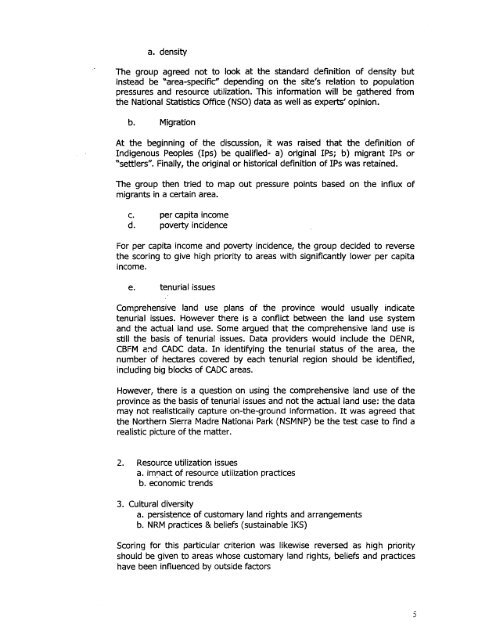United States Agency for International Development - (PDF, 101 mb ...
United States Agency for International Development - (PDF, 101 mb ...
United States Agency for International Development - (PDF, 101 mb ...
Create successful ePaper yourself
Turn your PDF publications into a flip-book with our unique Google optimized e-Paper software.
a. density<br />
The group agreed not to look at the standard definition of density but<br />
instead be "area-specific" depending on the site's relation to population<br />
pressures and resource utilization. This in<strong>for</strong>mation will be gathered from<br />
the National Statistics Office (NSO) data as well as experts' opinion.<br />
b. Migration<br />
At the beginning of the discussion, it was raised that the definition of<br />
Indigenous Peoples (Ips) be qualified- a) original IPS; b) migrant IPS or<br />
"settlers". Finally, the original or historical definition of IPS was retained.<br />
The group then tried to map out pressure points based on the influx of<br />
migrants in a certain area.<br />
c. per capita income<br />
d. poverty incidence<br />
For per capita income and poverty incidence, the group decided to reverse<br />
the scoring to give high priority to areas with significantly lower per capita<br />
Income.<br />
e. tenurial issues<br />
Comprehensive land use plans of the province would usually indicate<br />
tenurial issues. However there is a conflict between the land use system<br />
and the actual land use. Some argued that the comprehensive land use is<br />
still the basis of tenurial issues. Data providers would include the DENR,<br />
CBFM and CADC data. In identifying the tenurial status of the area, the<br />
nu<strong>mb</strong>er of hectares covered by each tenurial region should be identified,<br />
including big blocks of CADC areas.<br />
However, there is a question on using the comprehensive land use of the<br />
province as the basis of tenurial issues and not the actual land use: the data<br />
may not realistically capture on-the-ground in<strong>for</strong>mation. It was agreed that<br />
the Northern Sierra Madre Nationai Park (NSMNP) be the test case to find a<br />
realistic picture of the matter.<br />
2. Resource utilization issues<br />
a. im~act of resource utilization practices<br />
b. economic trends<br />
3. Cultural diversity<br />
a. persistence of customary land rights and arrangements<br />
b. NRM practices & beliefs (sustainable IKS)<br />
Scoring <strong>for</strong> this particular criterion was likewise reversed as high priority<br />
should be given to areas whose customary land rights, beliefs and practices<br />
have been influenced by outside factors

















